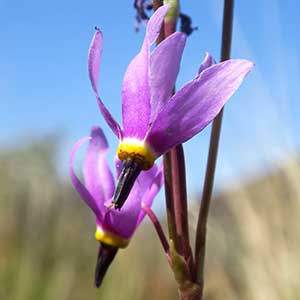Dodecatheon conjugens
Dodecatheon amethystinum
Bonneville shooting star, desert shootingstar, slim-pod shooting star
jeweled shootingstar
not obvious at anthesis;
roots whitish;
bulblets absent.
not obvious at anthesis;
roots white;
bulblets absent.
3–13(–18) × 0.7–2.5(–4) cm;
petiole slender (at least proximally);
blade narrowly oblanceolate to spatulate or obovate, base usually not decurrent onto stem, usually abruptly tapering to petiole, margins entire, surfaces glabrous or glandular-puberulent.
4–25 × 1–8 cm;
petiole often winged;
blade oblanceolate to oblong, base decurrent onto stem, often gradually tapering to petiole, margins entire, surfaces glabrous.
1–7(–10)-flowered;
bracts lanceolate to broadly lanceolate, 3–10 mm, glandular-puberulent.
1–10(–24)-flowered;
bracts narrowly or broadly lanceolate, 2–10 mm, glabrous.
1–5 cm, glabrous or glandular-puberulent.
1–5 cm, glandular at proximal 1 or 2 nodes, glabrous distally.
calyx light green to yellowish, sometimes finely purple-speckled or -dotted, 5–12 mm, glabrous or glandular-puberulent, tube 2–6 mm, lobes 5, 3–7 mm;
corolla tube yellowish with purplish red, thin, wavy ring, lobes 5, usually magenta, sometimes white, 7–25(–35) mm;
filaments usually distinct, yellowish or dark maroon, 0.5–1.5 mm, rarely partially connate and tube 0.5–1.5 × 1.5–5 mm;
anthers 5–9 mm;
pollen sacs usually maroon or yellow, sometimes yellowish and speckled maroon, rarely with reddish purple to purple speckles, connective usually maroon, sometimes yellowish or light blue to whitish, transversely rugose;
stigma not enlarged compared to style.
calyx light green to green, 3–8(–10) mm, glabrous, tube 3–5 mm, lobes 5, (1–)3–7 mm;
corolla tube usually maroon with maroon, thin, wavy ring, lobes 5, pink to purplish, rarely white, 8–20 mm;
filaments connate, tube maroon, 0.5–2(–2.5) × 2–3.5 mm;
anthers (3.5–)5–7.5(–8.5) mm;
pollen sacs reddish to maroon, rarely pale, connective maroon, smooth;
stigma not enlarged compared to style.
tan, often striped with purple, usually operculate, rarely valvate, cylindric-ovoid, 8–17(–22) × 4–6(–8) mm, glabrous;
walls thin, pliable.
light brown to reddish brown or yellowish, valvate, cylindric-ovoid, 7–16 × 3–5 mm, glabrous;
walls thin, pliable.
without membrane along edges.
without membrane along edges.
= 44.
Dodecatheon conjugens
Dodecatheon amethystinum
Varieties 2 (2 in the flora).
Both Dodecatheon conjugens and D. poeticum occur in proximity in the Columbia River gorge. Some specimens here assigned to var. conjugens may have scattered, minute glands on the pedicels that might indicate past hybridization with D. poeticum (e.g., G. N. Jones 6286, ORE; R. R. Halse 3790, OSC, WTU). Dodecatheon poeticum is densely glandular not only on the pedicels, but also on the calyx and scape. The type of minute glandular puberulence seen on var. conjugens found along the Columbia River west of The Dalles is somewhat similar to that seen on var. viscidum in western Montana and Canada. Some plants referred here to D. conjugens have slightly connate filaments that may indicate some intergradation with D. pulchellum var. pulchellum. This suggestion is supported by the tendency in the same plants to have narrower leaves.
Some newly emerged flowers tend to have connectives that are less rugose than normal. This is particularly true of some populations in southern Alberta and, to a lesser degree, in Saskatchewan.
(Discussion copyrighted by Flora of North America; reprinted with permission.)
Dodecatheon amethystinum is found mainly on, and at the bases of, limestone cliffs in hardwood forests from southwestern Wisconsin and adjacent southeastern Minnesota to northeastern Iowa, western Illinois, and eastern Missouri. It is disjunct to the eastern Appalachian Mountains of southeastern Pennsylvania; reports from northern West Virginia are based on specimens of D. meadia. Vegetatively, D. amethystinum is allied to D. meadia although its thin-walled (rather than thick and firm) fruit is like that of D. pulchellum. The only truly distinguishing feature between it and D. meadia is the fully mature capsules (L. H. Klotz and C. Loeffler 2007). In D. amethystinum, length of the light to reddish brown or yellowish capsule often is more than three times the diameter. The length of the dark reddish brown capsule of D. meadia is less than three times the diameter. As noted by H. H. Iltis and W. M. Shaughnessy (1960), D. amethystinum tends to grow on moist cliff faces and bluffs; D. meadia tends to occur on drier sites in prairie settings and in deciduous woodlands. Dodecatheon meadia is sometimes found in moist areas, and even on cliff faces; these sites are still comparatively drier. According to A. F. Cholewa, some populations in southern Minnesota that she considers to be D. amethystinum have leaves that are relatively broad and tend not to taper gradually to the petiole. In that light, continued recognition of D. amethystinum at the species level becomes dubious.
(Discussion copyrighted by Flora of North America; reprinted with permission.)
1. Leaf blades, scapes, and pedicels glabrous. | var. conjugens |
1. Leaf blades, scapes proximally, and pedicels usually glandular-puberulent. | var. viscidum |
- Local floras:
BC,
CA,
OR,
WA
- Local Web sites:
CalFlora,
CalPhotos,
Flora NW,
PNW Herbaria,
Turner Photog.
WildflowerSearch
iNaturalist (observations)
USDA Plants Database
- LBJ Wildflower Center
- SEINet
- Plants of the World Online
- Encyclopedia of Life
- Wikipedia
- Google Image Search


